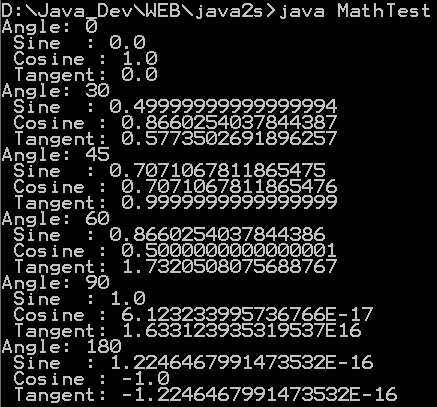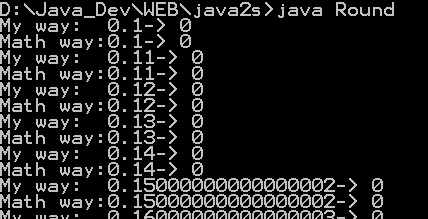Normalizes an angle to be near an absolute angle
/*******************************************************************************
* Copyright (c) 2001, 2008 Mathew A. Nelson and Robocode contributors
* All rights reserved. This program and the accompanying materials
* are made available under the terms of the Common Public License v1.0
* which accompanies this distribution, and is available at
* http://robocode.sourceforge.net/license/cpl-v10.html
*
* Contributors:
* Mathew A. Nelson
* - Initial API and implementation
* Flemming N. Larsen
* - Moved all methods to classes like FileUtil, StringUtil, WindowUtil,
* Logger etc. exception for the following methods, which have been kept
* here as legacy robots make use of these methods:
* - normalAbsoluteAngle()
* - normalNearAbsoluteAngle()
* - normalRelativeAngle()
* - The isNear() was made public
* - Optimized and provided javadocs for all methods
*******************************************************************************/
import static java.lang.Math.PI;
import java.util.Random;
/**
* Utility class that provide methods for normalizing angles.
*
* @author Mathew A. Nelson (original)
* @author Flemming N. Larsen (contributor)
*/
public class Utils {
private final static double TWO_PI = 2 * PI;
private final static double THREE_PI_OVER_TWO = 3 * PI / 2;
private final static double PI_OVER_TWO = PI / 2;
public static final double NEAR_DELTA = .00001;
/**
* Normalizes an angle to be near an absolute angle.
* The normalized angle will be in the range from 0 to 2*PI, where 2*PI
* itself is not included.
* If the normalized angle is near to 0, PI/2, PI, 3*PI/2 or 2*PI, that
* angle will be returned. The {@link #isNear(double, double) isNear}
* method is used for defining when the angle is near one of angles listed
* above.
*
* @param angle the angle to normalize
* @return the normalized angle that will be in the range of [0,2*PI[
* @see #normalAbsoluteAngle(double)
* @see #isNear(double, double)
*/
public static double normalNearAbsoluteAngle(double angle) {
angle = (angle %= TWO_PI) >= 0 ? angle : (angle + TWO_PI);
if (isNear(angle, PI)) {
return PI;
} else if (angle < PI) {
if (isNear(angle, 0)) {
return 0;
} else if (isNear(angle, PI_OVER_TWO)) {
return PI_OVER_TWO;
}
} else {
if (isNear(angle, THREE_PI_OVER_TWO)) {
return THREE_PI_OVER_TWO;
} else if (isNear(angle, TWO_PI)) {
return 0;
}
}
return angle;
}
/**
* Tests if the two {@code double} values are near to each other.
* It is recommended to use this method instead of testing if the two
* doubles are equal using an this expression: {@code value1 == value2}.
* The reason being, that this expression might never become
* {@code true} due to the precision of double values.
* Whether or not the specified doubles are near to each other is defined by
* the following expression:
* {@code (Math.abs(value1 - value2) < .00001)}
*
* @param value1 the first double value
* @param value2 the second double value
* @return {@code true} if the two doubles are near to each other;
* {@code false} otherwise.
*/
public static boolean isNear(double value1, double value2) {
return (Math.abs(value1 - value2) < NEAR_DELTA);
}
}
Related examples in the same category
| 1. | Absolute value | | |
| 2. | Find absolute value of float, int, double and long using Math.abs | | |
| 3. | Find ceiling value of a number using Math.ceil | | |
| 4. | Find exponential value of a number using Math.exp | | |
| 5. | Find floor value of a number using Math.floor | | |
| 6. | Find minimum of two numbers using Math.min | | |
| 7. | Find power using Math.pow | | |
| 8. | Find square root of a number using Math.sqrt | | |
| 9. | Find natural logarithm value of a number using Math.log | | |
| 10. | Find maximum of two numbers using Math.max | | |
| 11. | Get the power value | |  |
| 12. | Using the Math Trig Methods | |  |
| 13. | Using BigDecimal for Precision | |  |
| 14. | Demonstrate our own version round() | |  |
| 15. | Demonstrate a few of the Math functions for Trigonometry | |  |
| 16. | Exponential Demo | |  |
| 17. | Min Demo | | |
| 18. | Basic Math Demo | |  |
| 19. | Using strict math in applications | |  |
| 20. | Conversion between polar and rectangular coordinates | | |
| 21. | Using the pow() function | | |
| 22. | Using strict math at the method level | | |
| 23. | Calculating hyperbolic functions | | |
| 24. | Calculating trigonometric functions | | |
| 25. | Weighted floating-point comparisons | | |
| 26. | Solving right triangles | | |
| 27. | Applying the quadratic formula | | |
| 28. | Calculate the floor of the log, base 2 | | |
| 29. | Greatest Common Divisor (GCD) of positive integer numbers | | |
| 30. | Least Common Multiple (LCM) of two strictly positive integer numbers | | |
| 31. | Moving Average | | |
| 32. | Make Exponention | | |
| 33. | Caclulate the factorial of N | | |
| 34. | Trigonometric Demo | |  |
| 35. | Complex Number Demo | | |
| 36. | sqrt(a^2 + b^2) without under/overflow | | |
| 37. | Returns an integer hash code representing the given double array value. | | |
| 38. | Returns an integer hash code representing the given double value. | | |
| 39. | Returns n!. Shorthand for n Factorial, the product of the numbers 1,...,n as a double. | | |
| 40. | Returns n!. Shorthand for n Factorial, the product of the numbers 1,...,n. | | |
| 41. | Returns the hyperbolic sine of x. | | |
| 42. | Contains static definition for matrix math methods. | | |
| 43. | For a double precision value x, this method returns +1.0 if x >= 0 and -1.0 if x < 0. Returns NaN if x is NaN. | | |
| 44. | For a float value x, this method returns +1.0F if x >= 0 and -1.0F if x < 0. Returns NaN if x is NaN. | | |
| 45. | Normalize an angle in a 2&pi wide interval around a center value. | | |
| 46. | Normalizes an angle to a relative angle. | | |
| 47. | Normalizes an angle to an absolute angle | | |
| 48. | Returns the natural logarithm of n!. | | |
| 49. | Returns the least common multiple between two integer values. | | |
| 50. | Gets the greatest common divisor of the absolute value of two numbers | | |
| 51. | Matrix manipulation | | |
| 52. | Returns exact (http://mathworld.wolfram.com/BinomialCoefficient.html) Binomial Coefficient | | |
| 53. | Returns a double representation of the (http://mathworld.wolfram.com/BinomialCoefficient.html) Binomial Coefficient | | |
| 54. | Returns the natural log of the (http://mathworld.wolfram.com/BinomialCoefficient.html) Binomial Coefficient | | |
| 55. | Returns the hyperbolic cosine of x. | | |
| 56. | Math Utils | | |
| 57. | Implements the methods which are in the standard J2SE's Math class, but are not in in J2ME's. | | |
| 58. | Utility methods for mathematical problems. | | |
| 59. | A math utility class with static methods. | | |
| 60. | Computes the binomial coefficient "n over k" | | |
| 61. | Log Gamma | | |
| 62. | Log Beta | | |
| 63. | Beta | | |
| 64. | Gamma | | |
| 65. | Factorial | | |
| 66. | Computes p(x;n,p) where x~B(n,p) | | |
| 67. | Returns the sum of two doubles expressed in log space | | |
| 68. | sigmod | | |
| 69. | sigmod rev | | |
| 70. | Numbers that are closer than this are considered equal | | |
| 71. | Returns the KL divergence, K(p1 || p2). | | |
| 72. | Returns the sum of two doubles expressed in log space | | |
| 73. | Returns the difference of two doubles expressed in log space | | |
| 74. | Is Prime | | |
| 75. | Statistical functions on arrays of numbers, namely, the mean, variance, standard deviation, covariance, min and max | | |
| 76. | This class calculates the Factorial of a numbers passed into the program through command line arguments. | |  |
| 77. | Calculates the Greatest Common Divisor of two numbers passed into the program through command line arguments. | | |
| 78. | Variance: the square of the standard deviation. | | |
| 79. | Population Standard Deviation | | |
| 80. | Returns from a static prime table the least prime that is greater than or equal to a specified value. | | |